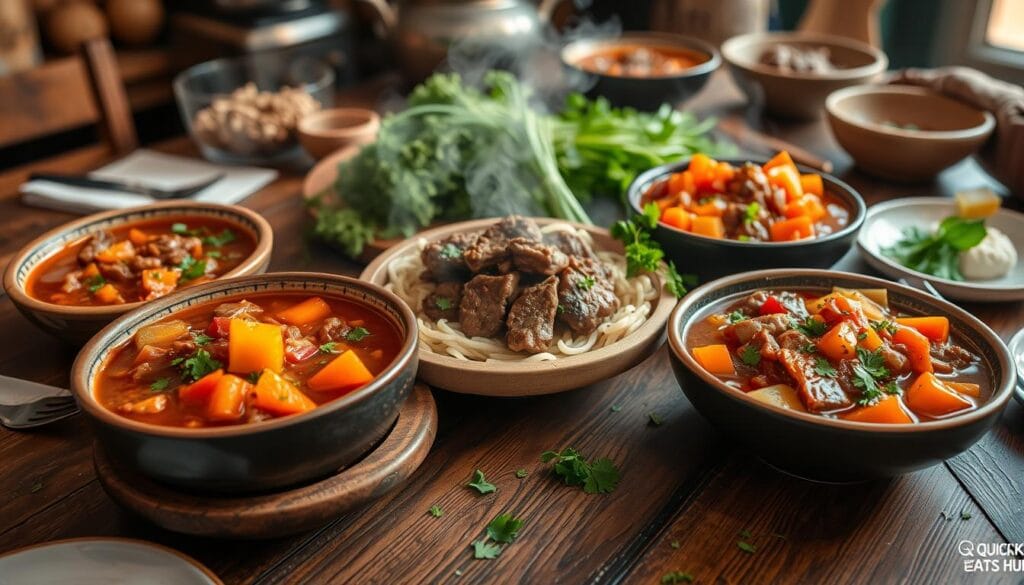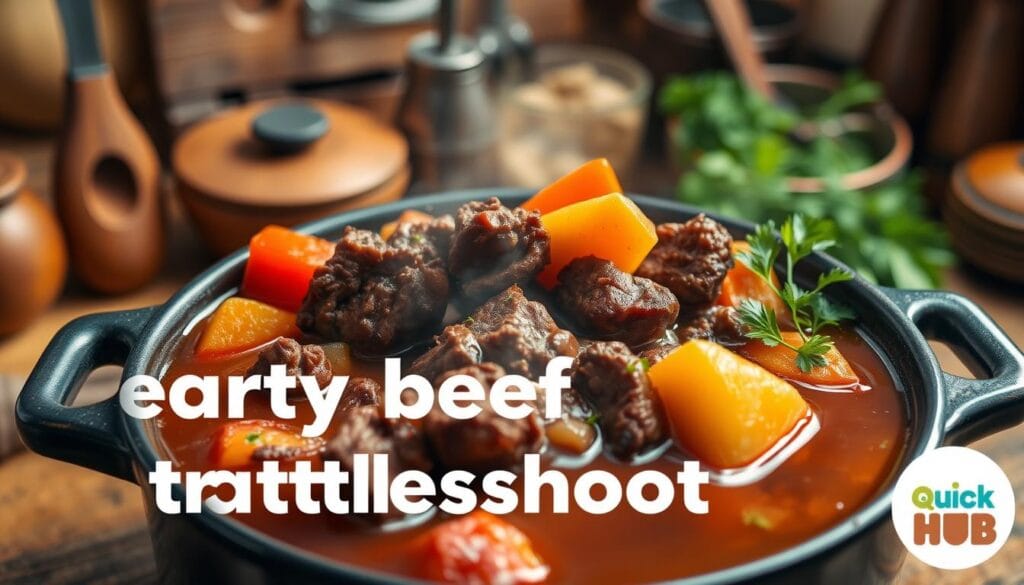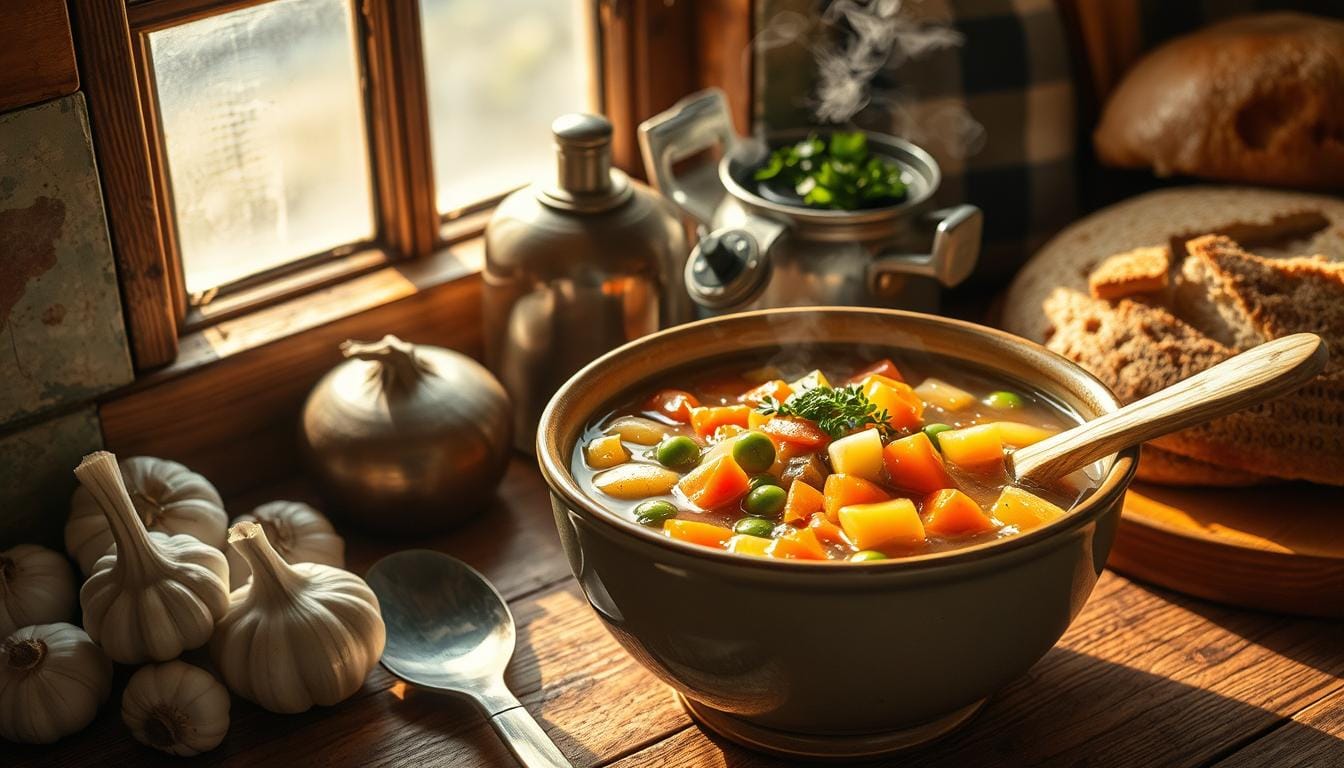The smell of old-fashioned vegetable beef soup brings back warm memories of childhood. I remember watching my grandmother make this hearty stew. Her hands moved with care as she chopped veggies and stirred the broth.
This veggie soup is more than food; it’s a family tradition. It’s filled with tender beef, colorful veggies, and a broth that warms the heart. It fills your kitchen with love and nostalgia.
Table of Contents
Introduction to Old-Fashioned Vegetable Beef Soup
Grandma’s vegetable soup is more than a meal. It’s a warm welcome to family traditions. This comforting soup brings families together, sharing delicious moments.
The beauty of this classic dish is its simplicity and rich flavor. Every spoonful shares a story of slow cooking and love. It’s made with care and the best ingredients.
“A good soup is like a warm hug from the kitchen” – Unknown Grandmother
- Serves 8 hearty cups
- Packed with nutritious ingredients
- Only 223 calories per serving
Traditional vegetable beef soup turns simple ingredients into a masterpiece. It’s all about slow simmering. This lets flavors blend, creating a taste that warms your heart.
If you’re facing a cold winter night or just need comfort, this recipe is perfect. It offers both nostalgia and nourishment.
Key Ingredients for Your Soup
Making a rustic beef veggie potage starts with picking the right ingredients. The quality of your soup depends on the ingredients you choose. They should work together to make a meal that’s both rich and satisfying.
Choosing the Right Cuts of Beef
The base of a tasty homemade beef vegetable medley is the beef. Beef shanks or chuck roast are the best choices for tenderness and flavor. Here are some options:
- 2-3 pounds of beef shanks
- Chuck roast cut into cubes
- Lean stew meat for maximum flavor
Essential Vegetables for Flavor
A carefully chosen vegetable medley brings your rustic beef veggie potage to life. The right mix of vegetables adds texture and taste:
| Vegetable | Quantity |
|---|---|
| Onions | 3/4 cup, coarsely chopped |
| Carrots | 1 cup, thinly sliced |
| Celery | 3/4 cup, chopped |
| Potatoes | 1 1/2 cups, diced |
| Green Beans | 1 1/2 cups, cut into 1-inch pieces |
| Cabbage | 2 cups, shredded |
Complementary Herbs and Spices
Add flavor to your homemade beef vegetable medley with these ingredients:
- 2 teaspoons Worcestershire sauce
- 1 teaspoon sugar (optional)
- Fresh herbs like thyme and bay leaves
“The secret to a great soup is in the quality of its ingredients and the love you put into preparing them.”
By choosing each ingredient with care, you’ll make a rustic beef veggie potage that warms the heart and satisfies the soul.
Preparing Your Ingredients
Making a tasty family-style beef vegetable stew starts with careful ingredient prep. The soup’s quality depends on how well you chop, slice, and prepare each part.
Chopping Techniques for Vegetables
Even cuts help your vegetables cook evenly and keep the texture right. Here are some tips for chopping:
- Carrots: Dice into 1/2-inch cubes for consistent cooking
- Celery: Slice thinly, about 1/4-inch thick
- Onions: Chop into small, even pieces
- Potatoes: Keep skin on and cut into bite-sized chunks
Slicing the Beef Properly
Choosing the right beef cut and slicing method can make your stew amazing.
| Beef Cut | Recommended Size | Cooking Benefit |
|---|---|---|
| Chuck Roast | 1-inch cubes | Tender, rich flavor |
| Stew Meat | 3/4-inch pieces | Quick cooking |
| Short Ribs | 1-inch chunks | Enhanced depth of flavor |
Pro Tip: Always slice against the meat’s grain to ensure maximum tenderness in your stew.
Being precise with your cuts turns raw ingredients into a delicious stew. It will warm hearts and fill bellies.
Cooking Methods for Best Results
To make the perfect slow-cooked beef soup, pick the right cooking method. This choice can turn a simple dish into a masterpiece. Whether you use the stovetop or a slow cooker, the outcome is crucial.
Stovetop Cooking Technique
For those who enjoy cooking themselves, the stovetop method is ideal. Use an 8-quart soup pot for enough room. The secret to a great soup is patience and low heat.
- Heat canola oil in the pot
- Brown 4 pounds of beef stew meat
- Add vegetables and herbs
- Pour 10 cups of lower-sodium beef broth
- Simmer for 1.5 to 2 hours
Convenient Slow Cooker Option
The slow cooker makes cooking easy. Set it and forget it is your motto. This way, flavors blend slowly all day long.
“A slow cooker transforms simple ingredients into a hearty meal with minimal effort.” – Home Cooking Experts
Slow cooker settings are flexible:
- Low setting: 6-8 hours of cooking
- High setting: 3-4 hours of cooking
- Ensure beef becomes fork-tender
- Add vegetables in the last hour
No matter your choice, aim for a soup with tender meat, cooked veggies, and a rich broth. This soup will warm you up from the inside.
Building Flavor Layers
Creating a delicious veggie soup starts with building flavor layers. Your hearty beef stew begins with two key steps. These steps turn simple ingredients into a tasty meal.
Searing the Beef: The Flavor Foundation
Searing beef is a game-changer for your veggie soup. It develops a deep, rich flavor that makes the dish better.
- Select 1.5 pounds of stew meat
- Cut meat into ¾” cubes for even cooking
- Use a hot, heavy-bottomed skillet
- Ensure meat is dry before searing
- Brown meat in batches to prevent steaming
Sautéing Vegetables: Unlocking Aromatic Potential
After searing the beef, use the same pan for sautéing vegetables. This method captures all the delicious browned bits. It makes the soup’s flavor even better.
| Vegetable | Nutrition | Sauté Tip |
|---|---|---|
| Onions | Low calorie, high flavor | Caramelize for sweetness |
| Celery | High in fiber | Chop finely for even cooking |
| Garlic | Rich in antioxidants | Add last to prevent burning |
“The secret to a perfect hearty beef stew is layering flavors, one ingredient at a time.” – Chef’s Wisdom
By carefully searing your beef and sautéing your vegetables, you’ll make a veggie soup full of depth and complexity. Each step adds to the last, turning simple ingredients into a memorable, comforting meal.
The Perfect Broth
Making a comforting vegetable beef broth is key to a memorable soup. The right liquid can turn your dish into something special. It adds rich, deep flavors that warm you up.
Your broth is the flavor base for your vegetable beef soup. Professional chefs know that the liquid you choose is crucial. It affects the taste and quality of your soup.
Using Beef Stock vs. Water
When making your comforting vegetable beef broth, keep these points in mind:
- Low-sodium beef broth adds more depth than water
- 4 cups of beef broth can make the flavor more intense
- Using both broth and water lets you control the taste
Why Homemade Stock is Worth It
“A great soup begins with a spectacular broth” – Chef’s Wisdom
Homemade stock makes your vegetable beef broth stand out. By simmering beef bones with vegetables for hours, you get a complex flavor. This is something store-bought can’t offer.
Here are the benefits of making your own stock:
- You have full control over sodium levels
- It tastes richer and more authentic
- It’s free from artificial preservatives and additives
Pro tip: Roast your beef bones before simmering. This unlocks deeper, more robust flavors in your comforting vegetable beef broth.
Cooking Time and Temperature
Getting the cooking time and temperature right is key to a perfect slow-cooked beef soup. It turns tough meat into tender, flavorful goodness that warms your heart.
Ideal Simmering Times for Tender Meat
Creating a top-notch slow-cooked beef soup takes time. Here’s what you need to do:
- Start by simmering the meat for 1-2 hours to make a rich broth.
- Cook the vegetables for about 45 minutes.
- For the best flavor, cook it all for 3-4 hours.
Temperature Control Techniques
Keeping the right temperature is crucial for a great slow-cooked beef soup. Here are some tips:
- Begin with high heat to sear the meat, adding deep flavors.
- Then, lower the heat to a gentle simmer (around 180-190°F).
- Don’t let it boil, as it can make veggies mushy and meat tough.
“Low and slow” is the secret to transforming ordinary ingredients into an extraordinary soup.
If you’re using a slow cooker, aim for 6-8 hours on low heat. This long cooking time lets the slow-cooked beef soup get rich flavors and keep the meat tender.
Pro tip: Use 2-3 pounds of beef shanks or rump roast for a hearty soup base. The long, gentle cooking breaks down the meat, making it tender and delicious.
Adding Nutritional Boosts
Turning your homemade beef vegetable medley into a nutritional powerhouse is easy. Just add the right ingredients. This will make your soup not just a meal, but a health-boosting comfort food.
Protein-Packed Beans
Beans are a great way to add protein and fiber to your medley. Here are some bean options:
- Kidney beans for a robust texture
- Black beans for rich mineral content
- Cannellini beans for a creamy consistency
Greens for Enhanced Nutrition
Leafy greens can greatly improve your soup’s nutrition. Spinach, kale, and Swiss chard are packed with benefits:
- High in vitamins A, C, and K
- Rich in antioxidants
- Adds vibrant color and fresh flavor
Tip: Add leafy greens in the last 5 minutes of cooking to preserve their nutritional integrity and bright color.
By adding beans and greens, you’ll make your homemade beef vegetable medley more balanced and nutritious. It will be good for your taste buds and your health.
Serving Suggestions
Transforming your family-style beef vegetable stew into a memorable meal is all about presentation. Choose the right bread and garnishes to make it stand out. This way, you can turn a simple dish into a culinary masterpiece.

Perfect Bread Pairings
Finding the right bread can make your stew even better. Here are some great choices:
- Crusty sourdough bread
- Warm garlic croutons
- Rustic whole grain rolls
- Buttered cornbread
Elegant Garnishes to Elevate Your Soup
Make your stew special with these garnishes:
- Fresh chopped parsley
- Grated Parmesan cheese
- Cracked black pepper
- A dollop of sour cream
“A great garnish is like the final brushstroke on a masterpiece painting – it completes the culinary experience.”
When serving your stew, presentation is key. Use warm ceramic bowls to keep it hot. Pair it with a crisp green salad for a nice contrast.
Serving Tips for Maximum Enjoyment
- Serve immediately after cooking for peak flavor
- Keep soup hot in a warmed serving dish
- Offer hot sauce on the side for heat lovers
- Allow guests to customize their garnishes
Your family-style beef vegetable stew is now ready to impress and satisfy!
Storing Leftovers
Your delicious old fashioned vegetable beef soup can be safely stored for future enjoyment. Proper storage ensures you can savor this hearty meal multiple times without compromising flavor or quality.
Best Practices for Refrigeration
When storing your vegetable beef soup in the refrigerator, follow these key guidelines:
- Use airtight containers to maintain freshness
- Cool the soup completely before refrigerating
- Store in the refrigerator for up to 3-4 days
- Keep the container sealed to prevent contamination
Freezing Your Soup for Future Meals
Freezing is an excellent way to extend the life of your old fashioned vegetable beef soup recipe. Here are some expert tips:
- Allow the soup to cool completely before freezing
- Use freezer-safe containers or heavy-duty freezer bags
- Leave about 1 inch of space at the top for expansion
- Label containers with the date of freezing
- Freeze for up to 3 months
“A well-stored soup is a treasure for busy days ahead!” – Home Cooking Wisdom
Reheating Tips
When you’re ready to enjoy your stored soup, follow these reheating recommendations:
- Thaw frozen soup overnight in the refrigerator
- Reheat gently on the stovetop for best results
- Stir occasionally to ensure even heating
- Add a splash of broth if the soup seems too thick
By following these storage techniques, you’ll ensure your old fashioned vegetable beef soup remains delicious and ready to warm you up whenever hunger strikes.
Variations on the Classic Recipe
Making a rustic beef veggie potage is fun because you can change it up. You can swap ingredients and add new twists. This keeps your meal fresh and tasty.
Exploring Vegetable Alternatives
This soup is great because you can try different veggies. You can make it taste unique:
- Use sweet potatoes for a sweeter flavor
- Add rutabaga for an earthy taste
- Try zucchini or okra for more texture
- Mix in mushrooms for a deep flavor
Spicing Up Your Soup
Changing the spice level can really change your soup. Here are some ways to add heat:
- Add diced jalapeños for a spicy kick
- Use a bit of hot sauce
- Put in red pepper flakes
| Variation | Ingredients to Swap | Cooking Time Adjustment |
|---|---|---|
| Gluten-Free | Cornstarch instead of flour | No change |
| Vegetarian | Mushrooms or lentils instead of beef | Reduce by 15-20 minutes |
| Chicken Version | Chicken breasts or thighs | Reduce to 30-40 minutes |
“The best recipes are the ones you make your own” – Cooking Wisdom
Remember, a great rustic beef veggie potage is about being creative. Don’t be shy to try new things!
Troubleshooting Common Issues
Cooking a perfect hearty beef stew can sometimes present challenges. Don’t worry – even experienced home chefs encounter occasional cooking hiccups. Understanding how to navigate these common issues will help you create a delicious meal every time.

Solving Thin Broth Challenges
A thin broth can diminish the rich experience of your hearty beef stew. Here are effective solutions to thicken your soup:
- Simmer the soup uncovered to naturally reduce liquid
- Create a cornstarch slurry by mixing 1 tablespoon cornstarch with cold water
- Mash some cooked potatoes directly into the broth
- Add a small amount of instant mashed potato flakes
Enhancing Lackluster Flavor Profiles
When your hearty beef stew lacks depth, try these flavor-boosting techniques:
- Sprinkle additional dried herbs like thyme or rosemary
- Add a splash of Worcestershire sauce
- Stir in a tablespoon of tomato paste
“The secret to a great stew is patience and careful seasoning.” – Professional Chef
Remember, cooking is an art of continuous adjustment. Taste your hearty beef stew throughout the cooking process and make incremental improvements. Your palate is the best guide to creating a memorable meal.
Conclusion: Enjoy Your Homemade Soup
Your journey with classic veggie soup is just beginning. It’s about making memories, not just cooking. This recipe combines nutritious ingredients and old-fashioned cooking methods. It turns simple parts into a meal that’s both comforting and healthy.
This soup is very flexible. You can keep leftovers in the fridge for 3-4 days or freeze them for up to 3 months. It’s great for family dinners or quick meals for one. Try it with crackers or focaccia bread for a cozy touch.
Sharing with Family and Friends
Invite your loved ones to enjoy this special dish. Your homemade soup serves 8, perfect for family gatherings. The mix of lean ground beef, baby potatoes, and seven veggies connects you to your family’s past.
Making This Recipe Your Own
Feel free to add your own twist to the classic veggie soup. Try fresh herbs like rosemary or thyme, or change up the veggies. Every change tells a new story, making the recipe your own and warming hearts for years.
FAQ
How long can I store old-fashioned vegetable beef soup?
Can I make this soup vegetarian?
What’s the best cut of beef for this soup?
How can I thicken the soup if it’s too thin?
Can I make this soup in a slow cooker?
How can I add more nutrition to the soup?
What are the best sides to serve with vegetable beef soup?
How can I make the soup more flavorful?
There are no reviews yet. Be the first one to write one.

